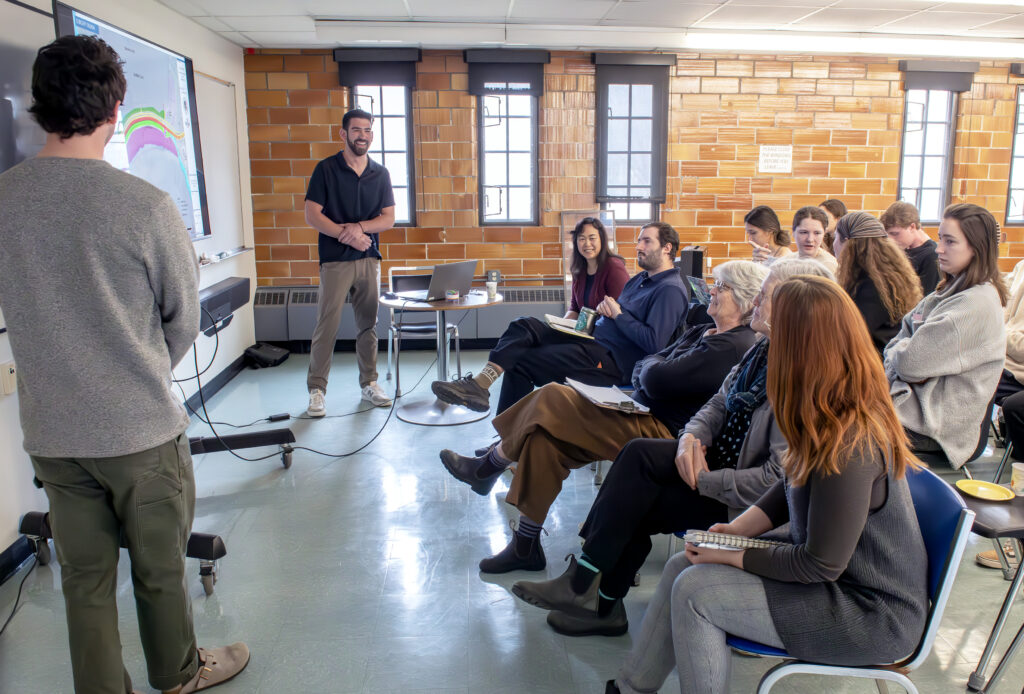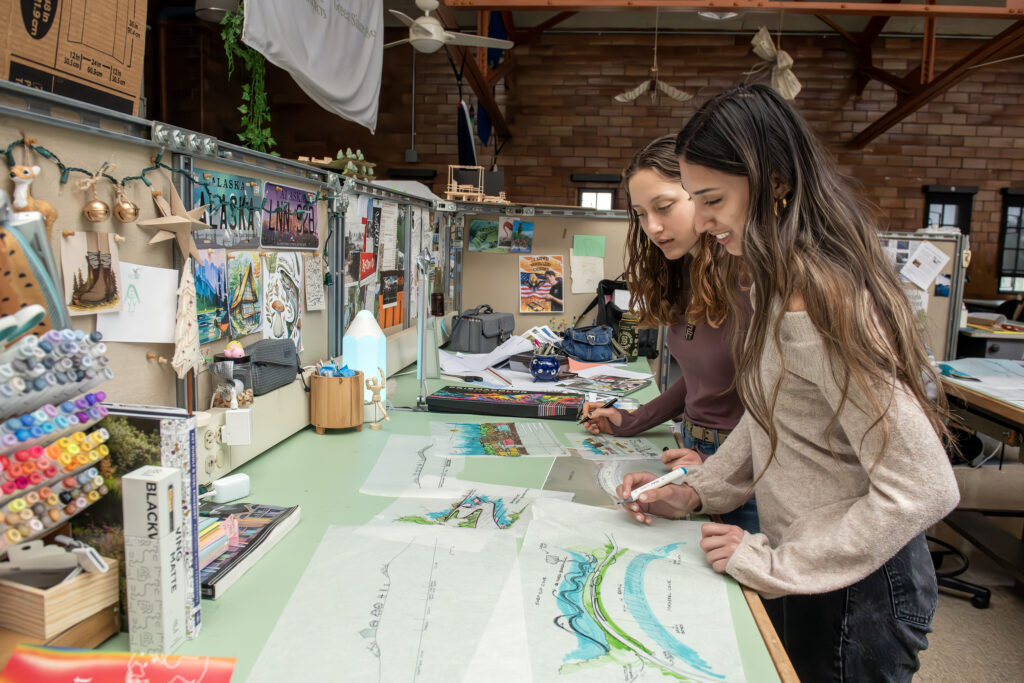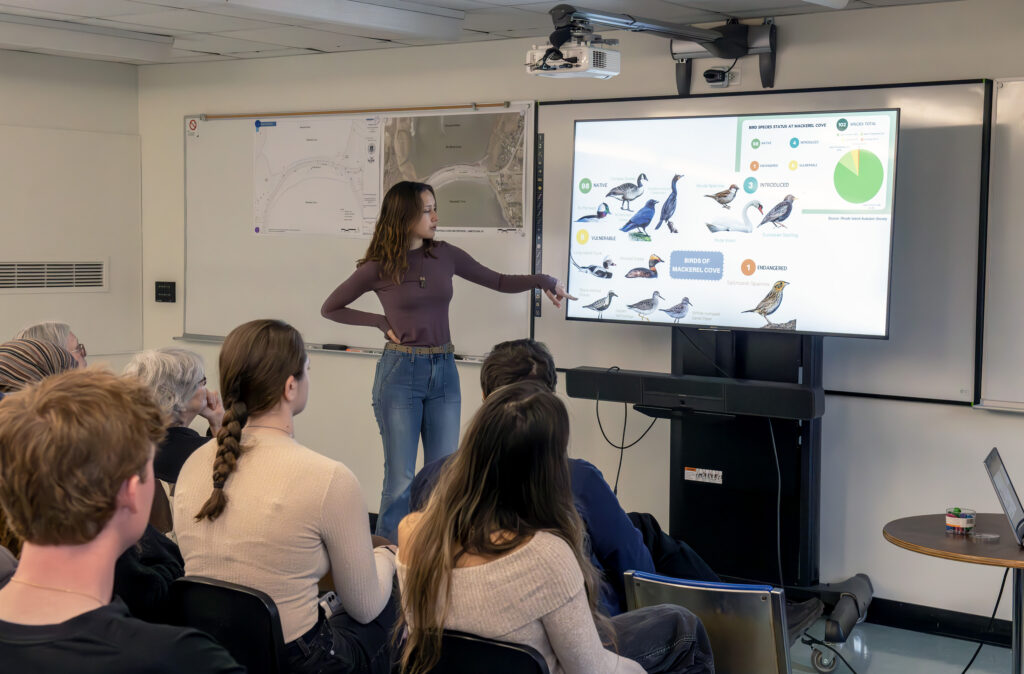
LAR445 students Adam Giroux, James Giesen, and Sam Bowen (not pictured) listen to feedback on their preliminary designs from Assistant Teaching Professor Hongbing Tang, Assistant Teaching Professor Gavin Zeitz; Mary Meagher, member of the Jamestown town council; Anne Kuhn, chair of the Jamestown Conservation Commission; and Assistant Teaching Professor Courtney Goode.
Bright green dune grass springs up around a wooden boardwalk, while a “complete street” design along elevated Beavertail Road features a shared bike path, bringing pedestrians and cyclists safely to Mackerel Cove Beach in Jamestown.
These were just some of the preliminary design ideas that University of Rhode Island senior landscape architecture (LAR) students recently presented at the midterm review of their capstone project looking at how to preserve Mackerel Cove Beach and the surrounding area from the impacts of sea level rise and storm flooding.

LAR445 capstone students (L-R) Katherine Ruzzo and Aisha Malik look over their preliminary drawings of designs for Mackerel Cove Beach.
The class, LAR445, is taught by registered landscape architect and Assistant Teaching Professor Hongbing Tang. Two community leaders from Jamestown and two other LAR faculty also attended the presentations and offered feedback.
The presentations came weeks after the students first visited Jamestown to view the Mackerel Cove Beach and adjacent Sheffield Cove and speak with town leaders, residents, and the parks and recreation director. They later held a community engagement workshop at the town council chamber where they gathered input from residents about what they would like to see—and not see—at the site. Two digital surveys (activity & general thought survey & design image preference survey) have also been posted online and shared by the local newspaper to collect community feedback.
Before discussing their preliminary design concepts, the students presented their site analysis and assessment studies of the site, which included work from both the LAR class and ocean engineering/civil engineering capstone students looking at the same site from an engineering perspective. They examined the history of storms that have impacted the beach, from the Hurricane of 1938 to Superstorm Sandy in 2012 as well as more recent storms in the present day. They discussed studies including the geology of the area, soil analysis, the microclimate, bathymetry, topography, vegetation, and bird species that frequent the cove areas, as well as noise, views, traffic circulation, and existing structures, among others.
Taking community feedback into consideration, students are exploring a range of creative design alternatives for resilient coastal interventions in Jamestown. Their concepts integrate nature-based solutions to protect the beach, mitigate flooding risks, enhance pedestrian safety, and improve accessibility, promoting a sustainable and inclusive approach to coastal resilience. They worked on the concept design for about two weeks prior to spring break and are continuing to refine their ideas following the midterm review.
After the presentation, Anne Kuhn, chair of the Jamestown Conservation Commission, said in an email, “It was fantastic to see the range of alternative future visions for Mackerel Cove and Sheffield Cove … I came away from these presentations with a sense of hope and inspiration—the students’ designs have expanded my mind on the range of possibilities for the area.”
The presentations highlighted how comprehensive the site considerations are that landscape architects must take into account.
Rhode Island Sea Grant has supported capstones like this one on coastal resilience for a number of years, in which a senior class in a discipline such as landscape architecture —but also at times ocean engineering, natural resource economics, and marine affairs—are matched with a municipality facing an issue linked to environmental change. The capstone provides the students the opportunity to work on a real-world challenge, and provides the city or town with a variety of creative ideas that can jumpstart their thinking on how to address the problem.
In a recent conversation about these capstones, Teresa Crean, who formerly managed Rhode Island Sea Grant’s workforce development portfolio, said of the program, “I think it … helps dispel some myths about what landscape architects do … It’s not just planting plants and drawing paving details and tree details and light fixtures and all of that, but it’s thinking about how landscapes work.”
Crean, now the city of Newport’s director of resilience and sustainability, said that she knows of three such capstone classes that have informed municipal plans in Newport, North Kingstown, and Westerly.
Jamestown has secured nearly $200,000 from the Rhode Island Infrastructure Bank to restore the dunes at Mackerel Cove, making the capstone projects exceptionally timely.
Students will have their final design review at the end of the spring semester. A final report will be prepared over the summer after the spring semester is over.
LAR445 is supported by Rhode Island Sea Grant as part of its commitment to workforce development in coastal community resilience.

